What Is Steampunk (to me)?
Posted by Rampant Coyote on May 19, 2014
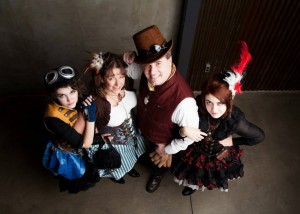 I do not have a “steampunk” game in development right now (but I do have a few ideas I’d love to explore in the future). My short story, “Dots, Dashes, and Deceit” is being released in the anthology Terra Mechanica: A Steampunk Anthology in two weeks. I love the subgenre, and I thought I’d try to explain why.
I do not have a “steampunk” game in development right now (but I do have a few ideas I’d love to explore in the future). My short story, “Dots, Dashes, and Deceit” is being released in the anthology Terra Mechanica: A Steampunk Anthology in two weeks. I love the subgenre, and I thought I’d try to explain why.
That’s my family on the right, in full steampunk regalia. The photography studio was pretty thrilled to shoot our family photos. Believe it or not, I was not the instigator here. Two years ago, my family dragged me to a local steampunk convention (Salt City Steamfest). I was not very interested. I was only there for one afternoon / evening, and the air conditioning at the convention center was not keeping up with the large number of people at all. I had to step outside into 92-degree weather to cool down. Yes, it was that bad.
But I still loved it. I attended a few of the more academic panels, and had a great time. Most people there are probably there just because of the fun deviations on Victorian-era costumes, and the overall aesthetic. That’s all cool and fun, but I was inspired by the storytelling possibilities.
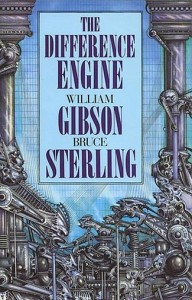 Backing up a little further… The first real “steampunk” novel I read was before it was a “thing.” It was The Difference Engine, by William Gibson and Bruce Sterling. While the storytelling wasn’t the greatest IMO (I’ve liked several novels by the authors individually, but this one didn’t thrill me as much), the concept was really cool. What if Babbage had managed to complete his Analytical Engine, and the Information Age came about by the mid 19th century instead of the mid-late 20th century? The novel explored some pretty cool “what ifs” – many of which revolved around what could possibly go wrong if the greatest imperialist nations of all time got its hands on that kind of technology. It considered the social and political ramifications, and seemed like a rich backdrop for a thousand fascinating stories.
Backing up a little further… The first real “steampunk” novel I read was before it was a “thing.” It was The Difference Engine, by William Gibson and Bruce Sterling. While the storytelling wasn’t the greatest IMO (I’ve liked several novels by the authors individually, but this one didn’t thrill me as much), the concept was really cool. What if Babbage had managed to complete his Analytical Engine, and the Information Age came about by the mid 19th century instead of the mid-late 20th century? The novel explored some pretty cool “what ifs” – many of which revolved around what could possibly go wrong if the greatest imperialist nations of all time got its hands on that kind of technology. It considered the social and political ramifications, and seemed like a rich backdrop for a thousand fascinating stories.
So then, a couple of decades later, my family is into this thing, which I think is mildly interesting, but I am not paying much attention. Meanwhile, I’m complaining here on the blog and other places about the relative dearth of alternative settings in things like role-playing games. Why are we stuck in Tolkien-esque worlds so much? Surely we can go beyond pseudo-medieval eras and still be successful, right? What else is there?
Then I get dragged to Salt City Steamfest, and a lightbulb turned on in my head – probably one of the impractical, pre-Edison light bulbs.
Steampunk is basically speculative fiction set in a world roughly analogous to our own around the time of Queen Victoria – think mid 1800s up to about World War I. That sounds simple enough, yet there are a lot of critics who try to narrow things down – particularly emphasizing the “punk” aspect of the term, necessitating social commentary rolled into the genre. The way I figure it – it’s kinda like the term “role-playing game” – it’s more of an inaccurate marketing term stamped on the category after the fact. (In jest, actually…) I don’t want to go too far with making that an exclusionary term.
Instead, the light-bulb that went off for me was about the wild, exciting flights of fantasy that could take place within this concept. It has the advantage of being relatively well-understood era today… more familiar to most people than the medieval era where most fantasy takes place. We’ve got photographs, family stories, and we haven’t quite lost everybody who was born in that age. It’s also an era that kinda brought us modern science fiction, with the works of H.G. Wells, Jules Verne, Edgar Allen Poe, and (a little earlier) Mary Shelley’s Frankenstein. Fun stuff!
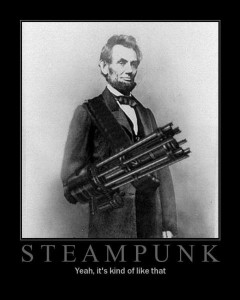 Since none of what would have been “science fiction” in that time period actually came to pass (at least not in the form it was envisioned), it could be considered “fantasy” today. That was kind of a liberating idea… someone could tell a science-fiction story set in the past, and it really becomes fantasy, and thus is freed from any temptation to be plausible. Of course that technology wouldn’t work! Who cares? A necromancer with a zombie army never led an assault against against the British Parliament in 1875, either, but who cares? That all fits.
Since none of what would have been “science fiction” in that time period actually came to pass (at least not in the form it was envisioned), it could be considered “fantasy” today. That was kind of a liberating idea… someone could tell a science-fiction story set in the past, and it really becomes fantasy, and thus is freed from any temptation to be plausible. Of course that technology wouldn’t work! Who cares? A necromancer with a zombie army never led an assault against against the British Parliament in 1875, either, but who cares? That all fits.
That was what it was for me – this willingness for steampunk to go balls-to-the-wall crazy by mixing whatever the hell they wanted into a loosely-defined time period and have fun with it. Let me put a bigger emphasis on that last phrase: have fun with it. I got into science fiction and fantasy as a kid because it was fun. It was escapist. Sure, it got serious, it made me think and reflect, it may have carried a “message” or two thinly veiled within metaphors. I’d go on these journeys to impossible worlds, and sometimes come back with something real – a new perspective about life, or people, or a willingness to think about things from a different perspective. But that was a secondary benefit. I went there – in books or games – because it was fun. A little vacation from reality.
I’ve usually enjoyed the blend of subgenres and historical eras in my science fiction and fantasy – from modern-era “urban fantasy” to pirates and musketeers fighting dragons and vampires. Steampunk, for me, was kind of the golden spike pulling it all together and connecting anything. It wasn’t just about 75-year-ish setting for speculative fiction. It was a reminder to let my inner child free and go nuts. From there, you can get all kinds of permutations and derivatives that can be equally fun. Retro-futuristic? Dieselpunk? Atompunk / Raygun Gothic? Weird West? Urban fantasy? Cyberpunk? It’s all good.
I come from the Star Wars generation, which had “knights” who acted like wizards wielding magical swords side-by-side with robots and spaceship pilots against laser-wielding soldiers, monsters, and walking tanks. Maybe that’s why, deep inside, the idea of coloring outside the genre lines sounds like fun to me. Speculative fiction doesn’t deserve to be be constrained by tiny boxes labeled with marketing terms. The definitions are just an attempt to make it possible to talk about this stuff. Mix and match to your hearts’ content, boys and girls. Life is too short to be a purist.
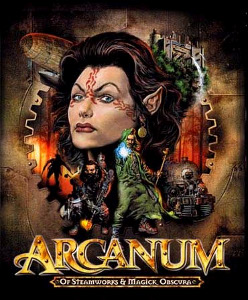 From the computer /console role-playing games side of things, I think the Final Fantasy series has always been a strange, alien blend of technology and magic. Arcanum: Of Steamworks and Magick Obscura by Troika Games was a more focused “steampunk” offering. I love the approach… they simply took what would have been a standard, run-of-the-mill fantasy world, with your usual elves, dwarves, orcs, gnomes, wizards, and so forth – and advanced it a few hundred years in technology and culture so that it kinda-sorta mirrored that of the Victorian era. Bastion would probably count. While not really an RPG, the Thief series – originally by Looking Glass – would qualify, though it has a bit more of a medieval aesthetic. Telepath RPG: Servants of God also has a bit of a steampunk aesthetic, but with a strong Middle-Eastern influence.
From the computer /console role-playing games side of things, I think the Final Fantasy series has always been a strange, alien blend of technology and magic. Arcanum: Of Steamworks and Magick Obscura by Troika Games was a more focused “steampunk” offering. I love the approach… they simply took what would have been a standard, run-of-the-mill fantasy world, with your usual elves, dwarves, orcs, gnomes, wizards, and so forth – and advanced it a few hundred years in technology and culture so that it kinda-sorta mirrored that of the Victorian era. Bastion would probably count. While not really an RPG, the Thief series – originally by Looking Glass – would qualify, though it has a bit more of a medieval aesthetic. Telepath RPG: Servants of God also has a bit of a steampunk aesthetic, but with a strong Middle-Eastern influence.
That’s just scratching the surface, of course. Particularly in the indie space, there are steampunk-themed games coming out pretty frequently. I haven’t checked them all out yet (I wish!), but it’s exciting to see some of the variety.
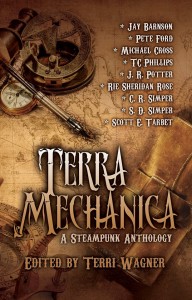 As I mentioned last week, my first foray as a published fiction writer is coming out in an anthology at the end of the month. My story, Dots, Dashes, and Deceit, is part of an anthology called Terra Mechanica: A Steampunk Anthology. The theme of the anthology was world travel, so there aren’t any stories stuck in Victorian London. So much for genre purist expectations!
As I mentioned last week, my first foray as a published fiction writer is coming out in an anthology at the end of the month. My story, Dots, Dashes, and Deceit, is part of an anthology called Terra Mechanica: A Steampunk Anthology. The theme of the anthology was world travel, so there aren’t any stories stuck in Victorian London. So much for genre purist expectations!
I will have more information and links soon. But hey, it has a Goodreads entry now!
So now, if you catch me going off on steampunk-related discussions in the future, you know why.
As always, folks… have fun!
Filed Under: Books, Design - Comments: 5 Comments to Read
Steve_Yorkshire said,
I’d recently been interviewed by Grogheads.com and said pretty much the same about Steampunk – it’s a lot more fun and a lot less po-faced than other aesthetics/genres of speculative fiction. http://grogheads.com/?p=4510
Tesh said,
That “speculative fiction” aspect is what caught my imagination. I love that it’s about exploring ideas. In my experience, modern sci-fi has become a morass of messaging and politics, and steampunk has inherited the mantle of just having fun with crazy ideas.
The great visual aesthetic is another thing that I really love about it. It’s a bit like the “lived in future” look of Star Wars, where things feel more true to life because they are beat up, grungy, and flat out goofy sometimes. It’s about people living the crazy ideas, and that’s really good to see.
I’ve certainly embraced what I see as the spirit of steampunk, the crazy tinkering with tech, visuals and ideas, with the Tinker projects I’ve done. It’s also something I’m using in my novel series I’m working on (ever so slowly, thanks to too many other priorities). It’s just a fun mental space to play in.
Anon said,
Steampunk came practically just after cyberpunk lived its short (commercially successful) life – and I hated it with a passion.
In my eyes it was the “murderer” of cyperpunk and Sterling and Gibson were being “traitors” (LOL).
After severeal years I began to like steampunk, especially when it’s very original, consistent and done tastefully.
CP and SP can and do coexist, although SP is probably a bit more mainstream-friendly, thanks to the works of Jules Verne – the first steampunk, IMHO.
Rampant Coyote said,
Heh – I was right there with you on the Cyberpunk thing. Maybe not to the point of viewing Sterling and Gibson as traitors, but while I enjoyed The Difference Engine, I did think it was a distraction from what they should be doing… which was more Cyberpunk!
I didn’t really think of Steampunk as much of a “thing” back then.
Anon said,
That’s how it appeared to me. “The new thing” – or to be more precise “The next thing” – as if SP is the evolutionary successor. But of course it wasn’t CP that evolved but the authors who *could* have continued CP but chose not to.
I couldn’t understand it back then (I was only about 18 or so) and, like you, I thought, that they should have done more. This was especially true for Gibson as I thought that the “Sprawl-Trilogy” was the truest form of CP and that the world he had created still had so much potential, even if were only used for a few more short stories. This was also the first time I longed for more of the same as a reader. I simply wasn’t as satiated as I later became with the Shadowrun series of novels.
So what’s left? Enjoying the small bits of CP we get treated every now and then! 😉